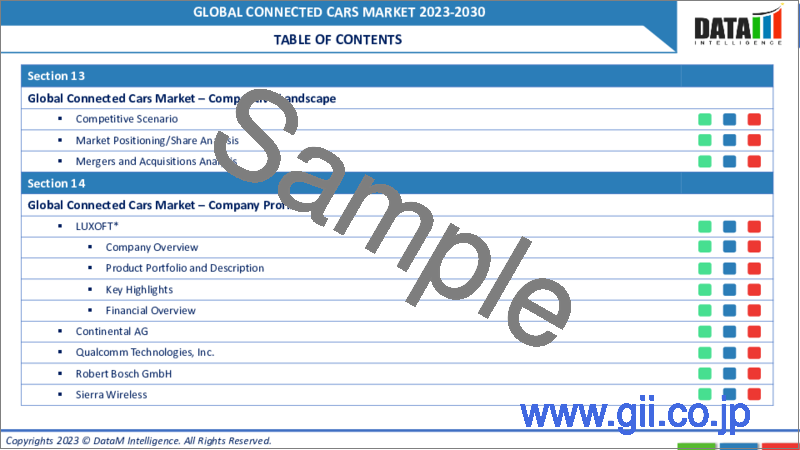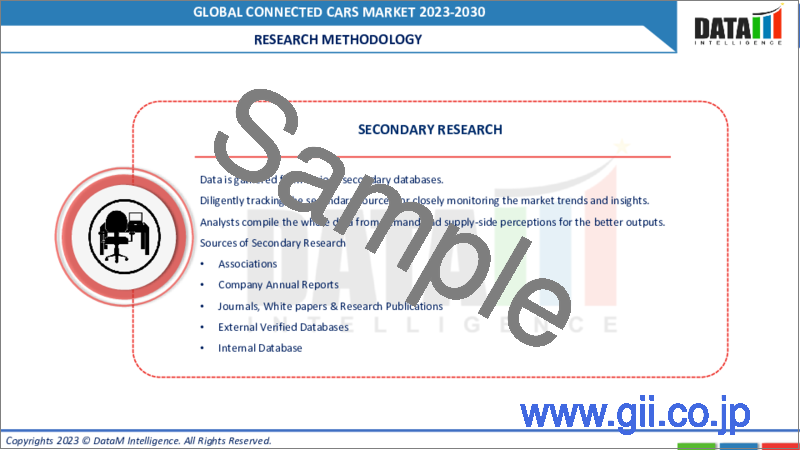|
|
市場調査レポート
商品コード
1304541
コネクテッドカーの世界市場-2023年~2030年Global Connected Cars Market - 2023-2030 |
||||||
カスタマイズ可能
適宜更新あり
|
|||||||
| コネクテッドカーの世界市場-2023年~2030年 |
|
出版日: 2023年07月07日
発行: DataM Intelligence
ページ情報: 英文 201 Pages
納期: 即日から翌営業日
|
- 全表示
- 概要
- 目次
市場概要
コネクテッドカーの世界市場は、2022年に235億米ドルに達し、2023~2030年の予測期間中にCAGR 18.5%で成長し、2030年には562億米ドルに達すると予測されます。
コネクテッドカー市場は、この技術によって車輪の接続が可能になり、快適性、利便性、性能、安全性、セキュリティが提供されることから、今後急拡大すると予想されます。コネクテッドカーの安全性に関するアプリケーションは、車両とインフラ(V2I)、車両(V2V)と相互間の通信を通じて状況認識を強化し、交通事故を減らすために考案されています。
促進要因をオンライン・プラットフォームに接続することで、リアルタイムのコミュニケーションが可能になります。予測期間中、世界のコネクテッドカー市場では、組み込み型セグメントが大きなシェアを占めると思われます。クラウドベースのサービスの台頭、政府の規制、サービスプランのコスト削減などが、関連する組み込みソリューションの拡大を後押ししています。
市場力学
安全性に関する政府規制の高まり
乗客の快適性、安全意識、安全機能を義務付ける政府の法規制により、ADAS車の生産台数が増加しており、コネクテッドカー市場の需要を牽引すると予想されます。世界中の政府は、安全性を管理し確保するために、いくつかの立法政策と規制の策定に注力しています。
いくつかの国で増加傾向にある交通事故の数を減らすために、政府は顧客にADASコンポーネントの車両への搭載を義務付け、奨励する政策を推進しています。例えば、車両の安全性を高めるため、インド政府はすでに二輪車にABSを義務化しています。インドでは、2022~2023年までに自動車にESC(横滑り防止装置)とAEB(自動緊急ブレーキ)を義務付ける方向で動いています。
成長する高度道路交通システム
車両と人間の間でデータを共有する最先端のアフターマーケット技術の適切な例は、コネクテッドカーで提供される安全サービスです。車両効率を高め、燃料消費とメンテナンスコストを削減し、セキュリティと安全対策を向上させ、 促進要因により良い全体的な運転体験を提供するために、安全性は通信と自動車技術の組み合わせです。
コネクテッドカーのもうひとつの特徴は運転支援システムで、目的地までどのルートを通ればよいかを 促進要因が選択できるように支援します。さらに、駐車スペースの空き状況や渋滞に関するアラートも表示されます。インテリジェント交通システムは、すべてのコネクテッド自動車技術によってアクセス可能になり、運転体験を向上させることを目的としています。
2022年6月、PATEO CorporationとQualcomm Technologies, Inc.(クアルコム)は関係を拡大し、スマート自動車接続、インテリジェント・コックピット、サービス指向アーキテクチャ(SOA)、中央制御装置に基づくマルチドメイン・フュージョンをサポートする製品を提供します。
サイバー攻撃のリスク
コネクテッドカー市場の拡大を制限する主な要因のひとつは、サイバー攻撃に対する脆弱性です。商用コンピューター・ネットワークでは膨大な量のデータが利用可能なため、コネクテッドカーの増加に伴い、ハッカーがインターネットに接続された自動車や自動運転車に大混乱を引き起こす機会が増えています。
車両性能データ、位置情報、個人情報などは、コネクテッドカーが収集・発信するデータのほんの一部に過ぎないです。車両のシステムに侵入するサイバー攻撃により、機密データの盗難や不正アクセスが発生する可能性があります。個人情報の盗難、プライバシーに関する懸念、個人情報の悪用の可能性が生じるかもしれないです。
COVID-19影響分析
COVID-19パンデミックは、ロックダウンと貿易制限によりサプライチェーンが混乱し、世界的に自動車生産が停止したため、世界のコネクテッドカー市場に大きな影響を与えました。COVID-19は、特に2020年2月の新車販売に大きな影響を与えました。例えば、中国の2月の新車販売台数は92%減少しました。
さらに、インドのような国家では、TVSやマヒンドラなど複数の自動車会社が生産と販売を停止し、幅広い産業に影響を与えました。しかし、制限が緩和されると、市場参入企業は、予測期間中に世界のコネクテッドカー市場の成長を促すために、こうしたリスクの軽減と前進に集中し始めました。
ロシア・ウクライナ戦争の影響
封鎖、制限、輸送の問題により、世界のサプライチェーンに混乱が生じた。ロシアでの事業停止を選択する自動車メーカーが増えています。ホンダ、日産、トヨタ、フォルクスワーゲン、ランボルギーニ、ボルボ、ジャガー・ランドローバー、アストン・マーチンなど、すべての自動車メーカーがロシアでの販売を中止しました。
ロシアによるウクライナ侵攻の反動で、金融取引や輸送ラインに混乱が生じていると報じられています。各組織は原材料不足に幅広く備えています。ガス、原油、アルミニウム、小麦、パラジウムなどの主要原材料の主要供給国のひとつがロシアです。また、これは世界のコネクテッドカー市場の成長を制限すると予想されています。
AIの影響
AIは、自動運転車から製造施設の産業用ロボットに至るまで、さまざまな形で自動車産業に影響を与えています。このため、メルセデス・ベンツ、トヨタ、フォルクスワーゲン、テスラ、ボルボ、ボッシュといった業界の大手企業は、顧客体験を向上させるためにAI技術を急速に導入しています。
その結果、自動車メーカーは自動運転車やコネクテッドカーのビジョンを達成するために、革新的なAIベースのソフトウェア開発ソリューションを急速に採用しています。その結果、自動車業界は現在、関連車両の設計と生産にAIを活用しており、自律走行車、電気自動車、ハイブリッド車が自動車業界の未来であることは明らかです。
目次
第1章 調査手法と調査範囲
第2章 定義と概要
第3章 エグゼクティブサマリー
第4章 市場力学
- 影響要因
- 促進要因
- ADAS機能に対する需要の高まり
- コネクティビティ・ソリューションの増加
- 安全性に関する政府規制の高まり
- インテリジェント交通システムの成長
- 抑制要因
- 中断のないインターネット接続の欠如
- サイバー攻撃のリスク
- 機会
- 影響分析
- 促進要因
第5章 産業分析
- ポーターのファイブフォース分析
- サプライチェーン分析
- 価格分析
- 規制分析
第6章 COVID-19分析
第7章 タイプ別
- 埋め込み型
- テザー
- 統合型
第8章 ネットワーク別
- 専用近距離通信
- セルラー
第9章 サービス別
- ナビゲーション
- 遠隔診断
- 衝突警告
- オートパーキング
- オートパイロット
- 車両管理
- サイバーセキュリティ
- センサー
- その他
第10章 ハードウェア別
- 電子制御ユニット
- インテリジェントアンテナ
- センサー
- キーレスエントリーシステム
- セントラルゲートウェイ
- ヘッドユニット
- テレマティクスコントロールユニット
第11章 地域別
- 北米
- 米国
- カナダ
- メキシコ
- 欧州
- ドイツ
- 英国
- フランス
- イタリア
- ロシア
- その他欧州
- 南米
- ブラジル
- アルゼンチン
- その他南米
- アジア太平洋
- 中国
- インド
- 日本
- オーストラリア
- その他アジア太平洋地域
- 中東・アフリカ
第12章 競合情勢
- 競合シナリオ
- 市況/シェア分析
- M&A分析
第13章 企業プロファイル
- LUXOFT
- 会社概要
- 製品ポートフォリオと説明
- 財務概要
- 最近の動向
- Continental AG
- Qualcomm Technologies, Inc.
- Robert Bosch GmbH
- Sierra Wireless
- Tesla
- Audi AG
- BMW Group
- Daimler AG
- Ford Motor Company
第14章 付録
Market Overview
The Global Connected Cars Market reached US$ 23.5 billion in 2022 and is expected to reach US$ 56.2 billion by 2030, growing with a CAGR of 18.5% during the forecast period 2023-2030.
The market for connected cars is expected to proliferate as the technology enables wheel connectivity and offers comfort, convenience, performance, safety and security. Applications for connected car safety are invented to enhance situational awareness and reduce traffic accidents through communications between vehicles and infrastructure (V2I) and vehicles(V2V) and each other.
Real-time communication becomes possible by connecting the driver to online platforms. During the forecast period, the embedded segment will hold a significant share of the global connected cars market. The rise of cloud-based services, government regulations, cost-cutting in service plans and other factors have all driven the expansion of associated embedded solutions.
Market Dynamics
Rising Government Regulations Regarding Safety
Growing ADAS car production due to passenger comfort, safety awareness and government legislation mandating safety features is expected to drive the connected cars market demand. Governments worldwide focus on developing several legislative policies and regulations to govern and ensure their safety.
To reduce the number of road accidents, which are on the rise in several countries, governments are promoting policies that would mandate and encourage customers to install ADAS components in vehicles. For instance, to increase vehicle safety, the Indian government has already made ABS a requirement for motorcycles. India is working to mandate Electronic Stability Control (ESC) and Autonomous Emergency Braking (AEB) in automotive by 2022-2023.
Growing Intelligent Transportation Systems
A suitable example of cutting-edge aftermarket technology which involves sharing data between the vehicle and humans is the safety services provided in connected cars. To increase vehicle efficiency, decrease fuel consumption and maintenance costs, improve security and safety measures and let the driver gain a better overall driving experience, safety is a combination of telecommunication and automotive technology.
Another feature in connected cars is the driver assistance system, which aids the driver in choosing which route to take to get to their destination. Additionally, it gives alerts about the availability of parking spaces and traffic jams. Intelligent transportation systems are made accessible by all connected automotive technologies and are intended to enhance the driving experience.
In June 2022, PATEO Corporation and Qualcomm Technologies, Inc. (Qualcomm) extended the relationship to provide products that support smart automobile connection, intelligent cockpits, service-oriented architecture (SOA) and multi-domain fusion based on central controllers.
Risk of Cyber Attacks
One of the main factors limiting the expansion of the connected cars market is vulnerability to cyber-attacks. Due to the huge quantity of data available in commercial computer networks, hackers have more opportunities to cause havoc in internet-linked cars and self-driving cars as the number of connected cars increases.
Vehicle performance data, location information and personal information are just a few data types connected cars collect and broadcast. Theft or unauthorized access to confidential data may arise from a cyber attack that breaches the vehicle's systems. Identity theft, concerns about privacy and potential misuse of personal data might result from it.
COVID-19 Impact Analysis
The COVID-19 pandemic significantly impacted the global connected cars market because of lockdowns and trade restrictions that caused supply chain disruptions and a global halt to car production. COVID-19 significantly moved new car sales, particularly in February 2020. For instance, new vehicle sales in China decreased by 92% in February.
Additionally, several automobile companies in a nation like India, including TVS and Mahindra, have halted production and sales due to the shutdown, impacting a wide range of industries. However, when limitations were eased, participants began concentrating on reducing these risks and advancements to encourage growth in the global connected cars market during the forecast period.
Russia- Ukraine War Impact
Lockdowns, limitations and transportation issues caused disruptions in the global supply chain. A growing number of automakers have chosen to stop doing business in Russia. All automakers discontinued sales in Russia, including Honda, Nissan, Toyota, Volkswagen, Lamborghini, Volvo, Jaguar Land Rover and Aston Martin.
The repercussions from Russia's invasion of Ukraine is reportedly causing disruptions to financial transactions and transportation lines. Organizations are preparing for a wide spectrum of raw material shortages. One of the major suppliers of key raw materials, including gas, crude oil, aluminum, wheat and palladium, is Russia. It is also anticipated to limit the growth of the global connected vehicles market.
AI Impact
AI has influenced the automotive industry in many ways, from self-driving cars to industrial robots in manufacturing facilities. Due to this, major industry giants like Mercedes-Benz, Toyota, Volkswagen, Tesla, Volvo, and Bosch rapidly implement AI technology to enhance the customer experience.
As a result, automotive manufacturers are rapidly adopting innovative AI-based software development solutions to achieve the vision of automated and connected vehicles. As a result, the automotive industry currently relies on AI for related vehicle design and production, making it apparent that autonomous, electric and hybrid vehicles are the future of the automotive industry.
Segment Analysis
The Global Connected Cars Market is segmented based on type, network, services, hardware and region.
Rising Demand for 5G Technology drives Cellular Network Growth.
The cellular network is expected to grow at the highest CAGR during the forecast period 2023-2030. Cellular network benefits, such as the reduction in the requirement for roadside infrastructure and the availability of highly reliable, real-time communication even in places with heavy traffic, encourage the segment's expansion. Additionally, it is expected that the development of 5G cellular technology and the growing deployment of 5G in developed countries will boost demand for cellular networks.
The 5G network's high speed and real-time cloud computing are expected to provide connected vehicles with a fast and secure connection. Multiple organizations are promoting the development of 5G integrated technologies for connected cars. For instance, in April 2022, Korea Electric Technology Institute (KETI) and Obigo Inc. (Obigo) collaboratively developed 5G-NR-V2X technologies for connected and autonomous driving automobiles.
Geographical Analysis
Growing Advancement of Automotive Technology in Asia-Pacific
Asia-Pacific is anticipated to grow significantly in the connected cars market during the forecast period. China has the fastest economic growth in the region due to the rapid growth of the automotive sector. In Asia-Pacific, consumption trends for connected cars are changing along with rising affordability.
With recent IoT and telematics developments that have increased connectivity, responses and communications, India is a growing technological hub that provides drivers, passengers and commuters with infotainment, security, safety and advanced vehicle management. Despite the pandemic, China remains one of the world's top vehicle producers, creating an excellent opportunity for connected technology to establish its position in the Chinese automotive industry.
With the launch of the new level 2 and level 3 ADAS capabilities, major automakers in China are upgrading their product portfolio. For instance, the new Chitu compact SUV from the HAVAL brand of Great Wall Motor Co. Ltd. launched in May 2021.
It is powered by a 1.5L turbocharged engine with a 7-speed wet dual-clutch gearbox and has a maximum power output of 135kW and a peak torque of 275Nm. The car also has a Level 2 ADAS system, with different features depending on the version.
Competitive Landscape
The major global players include: LUXOFT, Continental AG, Qualcomm Technologies, Inc., Robert Bosch GmbH, Sierra Wireless, Tesla, Audi AG, BMW Group, Daimler AG and Ford Motor Company.
Why Purchase the Report?
- To visualize the Global Connected Cars Market segmentation based on type, network, services, hardware and region, as well as understand key commercial assets and players.
- Identify commercial opportunities by analyzing trends and co-development.
- Excel data sheet with numerous connected cars market-level data points with all segments.
- PDF report consists of a comprehensive analysis after exhaustive qualitative interviews and an in-depth study.
- Product mapping available as Excel consisting of key products of all the major players.
The Global Connected Cars Market Report Would Provide Approximately 69 Tables, 75 Figures And 201 Pages.
Services 2023
- Manufacturers/ Buyers
- Industry Investors/Investment Bankers
- Research Professionals
- Emerging Companies
Table of Contents
1. Methodology and Scope
- 1.1. Research Methodology
- 1.2. Research Objective and Scope of the Report
2. Definition and Overview
3. Executive Summary
- 3.1. Snippet by Type
- 3.2. Snippet by Network
- 3.3. Snippet by Services
- 3.4. Snippet by Hardware
- 3.5. Snippet by Region
4. Dynamics
- 4.1. Impacting Factors
- 4.1.1. Drivers
- 4.1.1.1. Rising Demand for ADAS Feature
- 4.1.1.2. Rising Connectivity Solutions
- 4.1.1.3. Rising Government Regulations Regarding Safety
- 4.1.1.4. The Growing Intelligent Transportation Systems
- 4.1.2. Restraints
- 4.1.2.1. Lack of Uninterrupted Internet Connection
- 4.1.2.2. Risk of Cyber Attacks
- 4.1.3. Opportunity
- 4.1.4. Impact Analysis
- 4.1.1. Drivers
5. Industry Analysis
- 5.1. Porter's Five Force Analysis
- 5.2. Supply Chain Analysis
- 5.3. Pricing Analysis
- 5.4. Regulatory Analysis
6. COVID-19 Analysis
- 6.1. Analysis of COVID-19
- 6.1.1. Scenario Before COVID
- 6.1.2. Scenario During COVID
- 6.1.3. Scenario Post COVID
- 6.2. Pricing Dynamics Amid COVID-19
- 6.3. Demand-Supply Spectrum
- 6.4. Government Initiatives Related to the Market During Pandemic
- 6.5. Manufacturers Strategic Initiatives
- 6.6. Conclusion
7. By Type
- 7.1. Introduction
- 7.1.1. Market Size Analysis and Y-o-Y Growth Analysis (%), By Type
- 7.1.2. Market Attractiveness Index, By Type
- 7.2. Embedded*
- 7.2.1. Introduction
- 7.2.2. Market Size Analysis and Y-o-Y Growth Analysis (%)
- 7.3. Tethered
- 7.4. Integrated
8. By Network
- 8.1. Introduction
- 8.1.1. Market Size Analysis and Y-o-Y Growth Analysis (%), By Network
- 8.1.2. Market Attractiveness Index, By Network
- 8.2. Dedicated Short-Range Communication*
- 8.2.1. Introduction
- 8.2.2. Market Size Analysis and Y-o-Y Growth Analysis (%)
- 8.3. Cellular
9. By Services
- 9.1. Introduction
- 9.1.1. Market Size Analysis and Y-o-Y Growth Analysis (%), By Services
- 9.1.2. Market Attractiveness Index, By Services
- 9.2. Navigation*
- 9.2.1. Introduction
- 9.2.2. Market Size Analysis and Y-o-Y Growth Analysis (%)
- 9.3. Remote Diagnostics
- 9.4. Collision Warning
- 9.5. Auto Parking
- 9.6. Autopilot
- 9.7. Vehicle Management
- 9.8. Cybersecurity
- 9.9. Sensors
- 9.10. Others
10. By Hardware
- 10.1. Introduction
- 10.1.1. Market Size Analysis and Y-o-Y Growth Analysis (%), By Hardware
- 10.1.2. Market Attractiveness Index, By Hardware
- 10.2. Electronic Control Unit*
- 10.2.1. Introduction
- 10.2.2. Market Size Analysis and Y-o-Y Growth Analysis (%)
- 10.3. Intelligent Antenna
- 10.4. Sensors
- 10.5. Keyless Entry Systems
- 10.6. Central Gateway
- 10.7. Head Unit
- 10.8. Telematics Control Unit
11. By Region
- 11.1. Introduction
- 11.1.1. Market Size Analysis and Y-o-Y Growth Analysis (%), By Region
- 11.1.2. Market Attractiveness Index, By Region
- 11.2. North America
- 11.2.1. Introduction
- 11.2.2. Key Region-Specific Dynamics
- 11.2.3. Market Size Analysis and Y-o-Y Growth Analysis (%), By Type
- 11.2.4. Market Size Analysis and Y-o-Y Growth Analysis (%), By Network
- 11.2.5. Market Size Analysis and Y-o-Y Growth Analysis (%), By Services
- 11.2.6. Market Size Analysis and Y-o-Y Growth Analysis (%), By Hardware
- 11.2.7. Market Size Analysis and Y-o-Y Growth Analysis (%), By Country
- 11.2.7.1. The U.S.
- 11.2.7.2. Canada
- 11.2.7.3. Mexico
- 11.3. Europe
- 11.3.1. Introduction
- 11.3.2. Key Region-Specific Dynamics
- 11.3.3. Market Size Analysis and Y-o-Y Growth Analysis (%), By Type
- 11.3.4. Market Size Analysis and Y-o-Y Growth Analysis (%), By Network
- 11.3.5. Market Size Analysis and Y-o-Y Growth Analysis (%), By Services
- 11.3.6. Market Size Analysis and Y-o-Y Growth Analysis (%), By Hardware
- 11.3.7. Market Size Analysis and Y-o-Y Growth Analysis (%), By Country
- 11.3.7.1. Germany
- 11.3.7.2. The UK
- 11.3.7.3. France
- 11.3.7.4. Italy
- 11.3.7.5. Russia
- 11.3.7.6. Rest of Europe
- 11.4. South America
- 11.4.1. Introduction
- 11.4.2. Key Region-Specific Dynamics
- 11.4.3. Market Size Analysis and Y-o-Y Growth Analysis (%), By Type
- 11.4.4. Market Size Analysis and Y-o-Y Growth Analysis (%), By Network
- 11.4.5. Market Size Analysis and Y-o-Y Growth Analysis (%), By Services
- 11.4.6. Market Size Analysis and Y-o-Y Growth Analysis (%), By Hardware
- 11.4.7. Market Size Analysis and Y-o-Y Growth Analysis (%), By Country
- 11.4.7.1. Brazil
- 11.4.7.2. Argentina
- 11.4.7.3. Rest of South America
- 11.5. Asia-Pacific
- 11.5.1. Introduction
- 11.5.2. Key Region-Specific Dynamics
- 11.5.3. Market Size Analysis and Y-o-Y Growth Analysis (%), By Type
- 11.5.4. Market Size Analysis and Y-o-Y Growth Analysis (%), By Network
- 11.5.5. Market Size Analysis and Y-o-Y Growth Analysis (%), By Services
- 11.5.6. Market Size Analysis and Y-o-Y Growth Analysis (%), By Hardware
- 11.5.7. Market Size Analysis and Y-o-Y Growth Analysis (%), By Country
- 11.5.7.1. China
- 11.5.7.2. India
- 11.5.7.3. Japan
- 11.5.7.4. Australia
- 11.5.7.5. Rest of Asia-Pacific
- 11.6. Middle East and Africa
- 11.6.1. Introduction
- 11.6.2. Key Region-Specific Dynamics
- 11.6.3. Market Size Analysis and Y-o-Y Growth Analysis (%), By Type
- 11.6.4. Market Size Analysis and Y-o-Y Growth Analysis (%), By Network
- 11.6.5. Market Size Analysis and Y-o-Y Growth Analysis (%), By Services
- 11.6.6. Market Size Analysis and Y-o-Y Growth Analysis (%), By Hardware
12. Competitive Landscape
- 12.1. Competitive Scenario
- 12.2. Market Positioning/Share Analysis
- 12.3. Mergers and Acquisitions Analysis
13. Company Profiles
- 13.1. LUXOFT*
- 13.1.1. Company Overview
- 13.1.2. Product Portfolio and Description
- 13.1.3. Financial Overview
- 13.1.4. Recent Developments
- 13.2. Continental AG
- 13.3. Qualcomm Technologies, Inc.
- 13.4. Robert Bosch GmbH
- 13.5. Sierra Wireless
- 13.6. Tesla
- 13.7. Audi AG
- 13.8. BMW Group
- 13.9. Daimler AG
- 13.10. Ford Motor Company
LIST NOT EXHAUSTIVE
14. Appendix
- 14.1. About Us and Services
- 14.2. Contact Us






